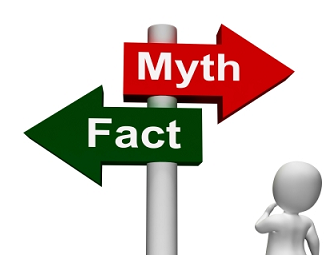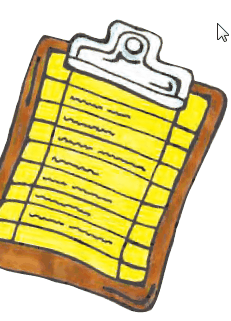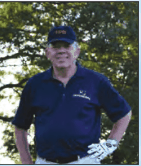Let’s Put These Old Myths To Rest For Good
 What do the Loch Ness Monster, Bigfoot, and the importance of keeping your head down in golf all have in common? Of course, they are myths, seeming to have some elements of plausibility, but in the end have yet to be demonstrated as true.
Here we are, a number of years into the 21st century, and many golf myths that have been debunked are still taken as gospel by countless amateurs, and unfortunately many golf teachers, as well. In the teaching and coaching professions, it is our responsibility to base our instruction on information that has proven to be true and scientifically sound. Let’s take a look at some of the more prevalent myths that are still believed by many in the golf world.
EQUIPMENT
“Slow swing speeds don’t compress a ball as much as faster swing speeds.” Tests of different swing speeds show that even modest swing speeds compress the ball just about as much as tour swing speeds. It really doesn’t take much to compress a ball. The USGTF Technical Committee found that a ball imprint of ¼” (.6 cm) diameter was left on a putter face after striking a 10-foot (3-meter) putt.
“Distance balls travel farther than tour balls off the tee.” This was true back in the balata ballera, but not today. The fact is that all balls travel about the same off the driver because tour-level balls are engineered to not spin very much with low-lofted clubs. However, with the medium and short irons, distance balls will travel a little farther due to having less spin than tour level balls with these clubs.
“Shafts that are too stiff cause slicing.” If you put stiff shafts into an Iron Byron hitting machine and program it at slow swing speeds, the ball will still go straight. Conversely, flexible shafts hit by an Iron Byron at tour speeds will still result in straight shots. The key is that people are not machines, and individual reactions will vary with ill-fit shafts.
INSTRUCTION
“Keep your head down (also keep your head still).” This is probably the most-imparted bit of instruction in golf history. If you talk to any accomplished instructor, they will tell you that this myth is also one of the most destructive tips ever given. It results in a lack of dynamic action through the ball, among other maladies. Yet, it continues to be the number one mantra of amateur golfers to their friends worldwide. Golfers can feel their heads coming up, yes, but that’s the result of other factors. And amateurs also notice their friends raising up through impact, but again, the head staying down is not the root cause. As responsible teachers and coaches, we should never tell anyone to keep their head down (or still).
“To cure a hook, play the ball more back; to cure a slice, play the ball more forward.” This bit of advice was dispensed by a professional golfer on a Golf Channel show, but it’s 100 percent incorrect. Although it seems to make sense at first glance, a slicer who plays the ball more forward will now be swinging more outside-in through impact than before, resulting in a bigger slice. And someone who hooks, who plays the ball farther back, will now have a more exaggerated inside-out path through impact, likely promoting a more severe hook.
“Keep your left arm straight.” While it shouldn’t collapse on the backswing, the left arm does not need to be straight. There are many fine players who play with a bent left arm on the back-swing, including former World Golf Teachers Cup champion Ken Butler, who is still an excellent player today.
“Impact position should be the same as the setup position.” You don’t hear this one much anymore, but it still has some traction among some instructors.
RULES
We could probably write several pages alone on rules myths, but we’ll limit the discussion to a few of the most common.
“If you knock a leaf off a branch on a practice backswing, it’s an automatic penalty.” Not necessarily. The standard is if knocking off the leaf (or leaves) improves the area of intended swing. In many cases, it doesn’t; hence, no penalty.
“Holding onto the removed flagstick while tapping in a putt is a penalty.” This is perfectly legal, unless the player is using the flagstick as an aid of some sort (such as steadying oneself in high winds). But since this is almost never the case, this is not a penalty.
“You can’t change the brand or model of ball you’re using during a round.” This is true only if the committee invokes the “one-ball rule” as a local rule. Otherwise, it’s legal for a player to play a Bridgestone on one hole and a Callaway on the next.
“It’s illegal to practice putt after the hole is over in stroke play; in match play, it’s okay.” This is an extremely prevalent belief, but wrong. Under Rule 7-2a, players are permitted to practice putt on the green of the hole they just played in both stroke play and match play. However, the committee has the power to prohibit this in either form of competition.
MISCELLANEOUS
“The ball flies farther in dry air because humid air is heavier.” This is 100 percent false, and probably the most-believed myth in golf outside of keeping the head down. Humid air is actually lighter than dry air, because water vapor molecules weigh less than nitrogen and oxygen molecules, which make up 99 percent of the atmosphere. What’s true is the ball will fly farther at higher altitudes and also in warmer air. Barometric pressure also plays a small role: The lower the pressure, the lighter the air.
“The best way to practice is to hit the same shot with the same club over and over.” Motor learning research has debunked this method of practice, called blocked practice. More efficient is random practice, where a different club is used, or at the very least a different shot is hit, from repetition to repetition. However, there is some evidence that hitting 2-3 shots in a row the same way with the same club (known as random blocks) can be as effective as true random practice.
“Golf is hard.” It depends on what the person is trying to accomplish. Making the tour? Yes. Having fun? No. We might be slightly biased, but the Technical Committee believes that golf was, is, and always will be the greatest individual game man ever invented.
What do the Loch Ness Monster, Bigfoot, and the importance of keeping your head down in golf all have in common? Of course, they are myths, seeming to have some elements of plausibility, but in the end have yet to be demonstrated as true.
Here we are, a number of years into the 21st century, and many golf myths that have been debunked are still taken as gospel by countless amateurs, and unfortunately many golf teachers, as well. In the teaching and coaching professions, it is our responsibility to base our instruction on information that has proven to be true and scientifically sound. Let’s take a look at some of the more prevalent myths that are still believed by many in the golf world.
EQUIPMENT
“Slow swing speeds don’t compress a ball as much as faster swing speeds.” Tests of different swing speeds show that even modest swing speeds compress the ball just about as much as tour swing speeds. It really doesn’t take much to compress a ball. The USGTF Technical Committee found that a ball imprint of ¼” (.6 cm) diameter was left on a putter face after striking a 10-foot (3-meter) putt.
“Distance balls travel farther than tour balls off the tee.” This was true back in the balata ballera, but not today. The fact is that all balls travel about the same off the driver because tour-level balls are engineered to not spin very much with low-lofted clubs. However, with the medium and short irons, distance balls will travel a little farther due to having less spin than tour level balls with these clubs.
“Shafts that are too stiff cause slicing.” If you put stiff shafts into an Iron Byron hitting machine and program it at slow swing speeds, the ball will still go straight. Conversely, flexible shafts hit by an Iron Byron at tour speeds will still result in straight shots. The key is that people are not machines, and individual reactions will vary with ill-fit shafts.
INSTRUCTION
“Keep your head down (also keep your head still).” This is probably the most-imparted bit of instruction in golf history. If you talk to any accomplished instructor, they will tell you that this myth is also one of the most destructive tips ever given. It results in a lack of dynamic action through the ball, among other maladies. Yet, it continues to be the number one mantra of amateur golfers to their friends worldwide. Golfers can feel their heads coming up, yes, but that’s the result of other factors. And amateurs also notice their friends raising up through impact, but again, the head staying down is not the root cause. As responsible teachers and coaches, we should never tell anyone to keep their head down (or still).
“To cure a hook, play the ball more back; to cure a slice, play the ball more forward.” This bit of advice was dispensed by a professional golfer on a Golf Channel show, but it’s 100 percent incorrect. Although it seems to make sense at first glance, a slicer who plays the ball more forward will now be swinging more outside-in through impact than before, resulting in a bigger slice. And someone who hooks, who plays the ball farther back, will now have a more exaggerated inside-out path through impact, likely promoting a more severe hook.
“Keep your left arm straight.” While it shouldn’t collapse on the backswing, the left arm does not need to be straight. There are many fine players who play with a bent left arm on the back-swing, including former World Golf Teachers Cup champion Ken Butler, who is still an excellent player today.
“Impact position should be the same as the setup position.” You don’t hear this one much anymore, but it still has some traction among some instructors.
RULES
We could probably write several pages alone on rules myths, but we’ll limit the discussion to a few of the most common.
“If you knock a leaf off a branch on a practice backswing, it’s an automatic penalty.” Not necessarily. The standard is if knocking off the leaf (or leaves) improves the area of intended swing. In many cases, it doesn’t; hence, no penalty.
“Holding onto the removed flagstick while tapping in a putt is a penalty.” This is perfectly legal, unless the player is using the flagstick as an aid of some sort (such as steadying oneself in high winds). But since this is almost never the case, this is not a penalty.
“You can’t change the brand or model of ball you’re using during a round.” This is true only if the committee invokes the “one-ball rule” as a local rule. Otherwise, it’s legal for a player to play a Bridgestone on one hole and a Callaway on the next.
“It’s illegal to practice putt after the hole is over in stroke play; in match play, it’s okay.” This is an extremely prevalent belief, but wrong. Under Rule 7-2a, players are permitted to practice putt on the green of the hole they just played in both stroke play and match play. However, the committee has the power to prohibit this in either form of competition.
MISCELLANEOUS
“The ball flies farther in dry air because humid air is heavier.” This is 100 percent false, and probably the most-believed myth in golf outside of keeping the head down. Humid air is actually lighter than dry air, because water vapor molecules weigh less than nitrogen and oxygen molecules, which make up 99 percent of the atmosphere. What’s true is the ball will fly farther at higher altitudes and also in warmer air. Barometric pressure also plays a small role: The lower the pressure, the lighter the air.
“The best way to practice is to hit the same shot with the same club over and over.” Motor learning research has debunked this method of practice, called blocked practice. More efficient is random practice, where a different club is used, or at the very least a different shot is hit, from repetition to repetition. However, there is some evidence that hitting 2-3 shots in a row the same way with the same club (known as random blocks) can be as effective as true random practice.
“Golf is hard.” It depends on what the person is trying to accomplish. Making the tour? Yes. Having fun? No. We might be slightly biased, but the Technical Committee believes that golf was, is, and always will be the greatest individual game man ever invented.



 There was a time – maybe until the mid-1980s or so – that a normal set of golf clubs consisting of 14 clubs had the following: a 1-wood (driver), 3-wood and a 5-wood; 2-iron through 9-iron, a pitching wedge, sand wedge and a putter. Among better players, it was not out of the ordinary to see a 1-iron thrown into the mix, usually replacing the 5-wood. Occasionally, you would see novelty clubs such as a 2-wood, a 6-wood, or a chipper in some-one’s bag, usually in place of the 2-iron.
Fast forward to 2017, and this set makeup is history. You would be hard pressed to find a golfer with the same make-up as his counterpart from 30 years ago. The first change occurred when Dave Pelz came up with the concept for the 60-degree wedge, known today as the lob wedge. Tom Kite, who worked with Pelz at the time, put the club into play in 1981, and other touring professionals eventually followed suit, even if not right away.
The next set change occurred in the early 1990s when Callaway Golf introduced multiple fairway woods consisting of the usual clubs along with the 7-wood, 9-wood, and 11-wood. LPGA Tour golfers were not hesitant to adopt these new clubs to replace their long irons, as they were easier to elevate and yet provided the same distance. In addition, their more forgiving properties allowed for better overall shot-making. Male professionals, on the other hand, largely elected to stay with their long irons, although these newer clubs did find their way into the bags of some male club golfers. The 7-wood (called the “Heaven-wood” by Callaway) became popular among the senior set, but a fair number of younger amateurs played the club, too.
At the time, it was somewhat prevalent among better players to snobbishly-proclaim that “real men” don’t use fairway woods, and most male golfers carried only a driver and 3-wood. Of course, a prominent golfer a few years later put what he described as an “old man’s club” in his bag, and seemed to relish the attention it brought. When Tiger Woods added that 5-wood to his arsenal, it signaled to his professional brethren that results, not appearances or macho behavior, were what counted.
TaylorMade Golf in 2003 introduced the next big change in golf, a change that has had a lasting effect on set makeup. The Rescue Mid Hybrid was the first hybrid golf club (a mix between an iron and fairway wood) that truly took off with mass sales that had staying power. Previous generations had hybrid precursors such as the Baffler and Ginty, but they were strictly novelty items, even though they were highly effective. Since TaylorMade by 2003 had the name recognition and credibility most golfers required in order to influence their purchases, the Rescue became a popular club among both professionals and amateurs in short order.
Senior professional golfer Dana Quigley in the mid-2000s was noted for having no iron higher than a 7-iron in his bag, and advised amateurs everywhere to follow his example. Although you don’t see many 2- and 3-irons in any amateurs’ bags these days, Quigley’s advice to dump the 4-, 5- and 6-iron has yet to take hold in wholesale fashion, but it’s common on today’s LPGA Tour for players to have a 5-iron as the lowest-numbered iron in their set. Some companies have introduced complete hybrid iron sets, but so far they haven’t gained widespread interest.
In contrast to the early 1980s, a set makeup today may consist of the driver, a 3- or 4-wood, 3-hybrid, 4- through 9-iron, a pitching wedge, gap wedge, sand wedge, lob wedge and a putter. That’s quite a difference. The gap wedge came into play when the standard pitching wedge loft, formerly at 50°, changed for many companies to 46°, or even lower, in some sets. Since the standards and wedge loft has held steady at about 56°, there became too much of a distance gap between the pitching and sand wedges. Thus, companies rushed to fill the void with a gap, or approach, wedge.
Things have certainly changed in set makeup these past 30 years, but there was a time when many golfers carried fewer clubs and had an entirely different composition when shafts were made out of hickory. Golfers a century ago may have carried anywhere from 6-10 clubs. Francis Ouimet won the 1913 U.S.Open with just seven clubs, and they can be seen in the famous picture of him with caddie Eddie Lowery walking down the fairway.
One of the reasons to carry so few clubs was the relatively high cost of each individual club. As steel shafts came into prevalence and made clubs more affordable, golfers continued to add clubs to their bag. Lawson Little won the 1934 and 1935 British and U.S. Amateur tournaments carrying anywhere between 26 and 31 clubs. Caddies everywhere were grateful when the USGA and R&A soon limited the number of clubs to 14.
The set makeup of tomorrow may consist of club designs yet to be invented, but if history is our guide, will surely one day differ from what we see today.
There was a time – maybe until the mid-1980s or so – that a normal set of golf clubs consisting of 14 clubs had the following: a 1-wood (driver), 3-wood and a 5-wood; 2-iron through 9-iron, a pitching wedge, sand wedge and a putter. Among better players, it was not out of the ordinary to see a 1-iron thrown into the mix, usually replacing the 5-wood. Occasionally, you would see novelty clubs such as a 2-wood, a 6-wood, or a chipper in some-one’s bag, usually in place of the 2-iron.
Fast forward to 2017, and this set makeup is history. You would be hard pressed to find a golfer with the same make-up as his counterpart from 30 years ago. The first change occurred when Dave Pelz came up with the concept for the 60-degree wedge, known today as the lob wedge. Tom Kite, who worked with Pelz at the time, put the club into play in 1981, and other touring professionals eventually followed suit, even if not right away.
The next set change occurred in the early 1990s when Callaway Golf introduced multiple fairway woods consisting of the usual clubs along with the 7-wood, 9-wood, and 11-wood. LPGA Tour golfers were not hesitant to adopt these new clubs to replace their long irons, as they were easier to elevate and yet provided the same distance. In addition, their more forgiving properties allowed for better overall shot-making. Male professionals, on the other hand, largely elected to stay with their long irons, although these newer clubs did find their way into the bags of some male club golfers. The 7-wood (called the “Heaven-wood” by Callaway) became popular among the senior set, but a fair number of younger amateurs played the club, too.
At the time, it was somewhat prevalent among better players to snobbishly-proclaim that “real men” don’t use fairway woods, and most male golfers carried only a driver and 3-wood. Of course, a prominent golfer a few years later put what he described as an “old man’s club” in his bag, and seemed to relish the attention it brought. When Tiger Woods added that 5-wood to his arsenal, it signaled to his professional brethren that results, not appearances or macho behavior, were what counted.
TaylorMade Golf in 2003 introduced the next big change in golf, a change that has had a lasting effect on set makeup. The Rescue Mid Hybrid was the first hybrid golf club (a mix between an iron and fairway wood) that truly took off with mass sales that had staying power. Previous generations had hybrid precursors such as the Baffler and Ginty, but they were strictly novelty items, even though they were highly effective. Since TaylorMade by 2003 had the name recognition and credibility most golfers required in order to influence their purchases, the Rescue became a popular club among both professionals and amateurs in short order.
Senior professional golfer Dana Quigley in the mid-2000s was noted for having no iron higher than a 7-iron in his bag, and advised amateurs everywhere to follow his example. Although you don’t see many 2- and 3-irons in any amateurs’ bags these days, Quigley’s advice to dump the 4-, 5- and 6-iron has yet to take hold in wholesale fashion, but it’s common on today’s LPGA Tour for players to have a 5-iron as the lowest-numbered iron in their set. Some companies have introduced complete hybrid iron sets, but so far they haven’t gained widespread interest.
In contrast to the early 1980s, a set makeup today may consist of the driver, a 3- or 4-wood, 3-hybrid, 4- through 9-iron, a pitching wedge, gap wedge, sand wedge, lob wedge and a putter. That’s quite a difference. The gap wedge came into play when the standard pitching wedge loft, formerly at 50°, changed for many companies to 46°, or even lower, in some sets. Since the standards and wedge loft has held steady at about 56°, there became too much of a distance gap between the pitching and sand wedges. Thus, companies rushed to fill the void with a gap, or approach, wedge.
Things have certainly changed in set makeup these past 30 years, but there was a time when many golfers carried fewer clubs and had an entirely different composition when shafts were made out of hickory. Golfers a century ago may have carried anywhere from 6-10 clubs. Francis Ouimet won the 1913 U.S.Open with just seven clubs, and they can be seen in the famous picture of him with caddie Eddie Lowery walking down the fairway.
One of the reasons to carry so few clubs was the relatively high cost of each individual club. As steel shafts came into prevalence and made clubs more affordable, golfers continued to add clubs to their bag. Lawson Little won the 1934 and 1935 British and U.S. Amateur tournaments carrying anywhere between 26 and 31 clubs. Caddies everywhere were grateful when the USGA and R&A soon limited the number of clubs to 14.
The set makeup of tomorrow may consist of club designs yet to be invented, but if history is our guide, will surely one day differ from what we see today. 
 Who dares to teach must never cease to learn.” These words by the great American librarian and museum director John Cotton Dana are incredibly profound, even given their brevity and seeming simplicity.
Who dares to teach must never cease to learn.” These words by the great American librarian and museum director John Cotton Dana are incredibly profound, even given their brevity and seeming simplicity.

 JOE BERMEL, known as The Putting Doctor, chooses players known for their putting prowess, naturally. Bermel has been teaching for twelve years at My Putting Doctor Private Teaching Facility, on Long Island, New York, his own facility. To complete his foursome, he would pick Jack Nicklaus, Tiger Woods and Phil Mickelson.
“I chose them because they are great players and great putters,” Bermel says. “Our golf game would be light hearted yet serious.”
In his instruction, Bermel focuses on putting and the entire short game. As he was a top contender at the World Putting Championship, Bermel knows of what he speaks. He has produced two volumes of copyrighted DVDs, How to Putt Well, has performed The Putting Doctor Road Show with golf celebrities, and has enjoyed extensive media coverage.
Bermel chose Nicklaus “for his pre-putt routine.” Bermel teaches his own brand of routine, but would like to see first-hand what Nicklaus does. The same goes for Mickelson, whose pre-putt routine is more meticulous and repetitive than that of most other golfers, according to Bermel, “which is why he is one of the best putters in the world.”As for Tiger Woods, “one of the best golfers ever,” Bermel admires his general demeanor during play. Bermel would tell his students to “do it like Tiger does it. Copy Tiger.” He would advise his students to buy these players’ books and instructional manuals to learn more about their secrets to playing at the level they do.
STEVE K
JOE BERMEL, known as The Putting Doctor, chooses players known for their putting prowess, naturally. Bermel has been teaching for twelve years at My Putting Doctor Private Teaching Facility, on Long Island, New York, his own facility. To complete his foursome, he would pick Jack Nicklaus, Tiger Woods and Phil Mickelson.
“I chose them because they are great players and great putters,” Bermel says. “Our golf game would be light hearted yet serious.”
In his instruction, Bermel focuses on putting and the entire short game. As he was a top contender at the World Putting Championship, Bermel knows of what he speaks. He has produced two volumes of copyrighted DVDs, How to Putt Well, has performed The Putting Doctor Road Show with golf celebrities, and has enjoyed extensive media coverage.
Bermel chose Nicklaus “for his pre-putt routine.” Bermel teaches his own brand of routine, but would like to see first-hand what Nicklaus does. The same goes for Mickelson, whose pre-putt routine is more meticulous and repetitive than that of most other golfers, according to Bermel, “which is why he is one of the best putters in the world.”As for Tiger Woods, “one of the best golfers ever,” Bermel admires his general demeanor during play. Bermel would tell his students to “do it like Tiger does it. Copy Tiger.” He would advise his students to buy these players’ books and instructional manuals to learn more about their secrets to playing at the level they do.
STEVE K UZMIC, who teaches in the San Francisco Bay area, has been a USGTF member for three years and is in the process of formulating his thesis for certification as a USGTF Master Golf Teaching Professional. He and his teaching partner, Rob Wollack, are working on building an indoor instructional facility in San Francisco’s SoMa District. They have not yet settled on a name for their facility.
We’re like the Beatles,” says Kuzmic, who finds joy, solace and balance in golf. “They wrote their music first, then the lyrics afterwards.”
Kuzmic, whose father escaped Communism in the former Yugoslavia by “running away with an accordion on his back,” grew up playing classical piano, and now produces music of his own “mel-low electronic genre.” He has “traveled the world as a DJ.” These days he also makes beautiful music on the golf course and the lesson tee.
He first was introduced to golf twenty-five years ago by his brother-in-law, Clay Stokes, who represents Kuzmic’s first pick for his ideal living foursome.
“Clay started me on the range,” says Kuzmic, who has been teaching golf for fifteen years. “He put a difficult 4-iron in my hands and gave me a couple of pieces of advice, and I was off and running. It’s the opposite of how people learn today.”
Kuzmic also would include Lee Trevino. “He is an everyman,” Kuzmic says, “hilarious. He comes from humble beginnings. He has a low ball flight, yet won a U.S. Open. I love his scrappiness and creativity, showing that anyone can play and win at the highest level.” These are Trevino’s qualities that Kuzmic would try to impart to his students after playing around with the famous Texan with the self-taught style.
Ernie Els would be Kuzmic’s fourth. “I’ve modeled my swing after The Big Easy,” says Kuzmic. “I’m a pretty mellow guy myself.”
Big on playing lessons rather than repetitive practice on the range, Kuzmic would learn from his dream foursome while playing at his dream venue, Pebble Beach Golf Links, in Pebble Beach, California.
“I would love to see Lee and Ernie interact,” says Kuzmic. “Lee would get us all laughing. It would be awesome to see two pros so different from each other play the beautiful game of golf. We would all four hit some amazing shots.”
UZMIC, who teaches in the San Francisco Bay area, has been a USGTF member for three years and is in the process of formulating his thesis for certification as a USGTF Master Golf Teaching Professional. He and his teaching partner, Rob Wollack, are working on building an indoor instructional facility in San Francisco’s SoMa District. They have not yet settled on a name for their facility.
We’re like the Beatles,” says Kuzmic, who finds joy, solace and balance in golf. “They wrote their music first, then the lyrics afterwards.”
Kuzmic, whose father escaped Communism in the former Yugoslavia by “running away with an accordion on his back,” grew up playing classical piano, and now produces music of his own “mel-low electronic genre.” He has “traveled the world as a DJ.” These days he also makes beautiful music on the golf course and the lesson tee.
He first was introduced to golf twenty-five years ago by his brother-in-law, Clay Stokes, who represents Kuzmic’s first pick for his ideal living foursome.
“Clay started me on the range,” says Kuzmic, who has been teaching golf for fifteen years. “He put a difficult 4-iron in my hands and gave me a couple of pieces of advice, and I was off and running. It’s the opposite of how people learn today.”
Kuzmic also would include Lee Trevino. “He is an everyman,” Kuzmic says, “hilarious. He comes from humble beginnings. He has a low ball flight, yet won a U.S. Open. I love his scrappiness and creativity, showing that anyone can play and win at the highest level.” These are Trevino’s qualities that Kuzmic would try to impart to his students after playing around with the famous Texan with the self-taught style.
Ernie Els would be Kuzmic’s fourth. “I’ve modeled my swing after The Big Easy,” says Kuzmic. “I’m a pretty mellow guy myself.”
Big on playing lessons rather than repetitive practice on the range, Kuzmic would learn from his dream foursome while playing at his dream venue, Pebble Beach Golf Links, in Pebble Beach, California.
“I would love to see Lee and Ernie interact,” says Kuzmic. “Lee would get us all laughing. It would be awesome to see two pros so different from each other play the beautiful game of golf. We would all four hit some amazing shots.”
 SHARON BARLEY, a USGTF member, holds a Master of Divinity as well as a Doctorate in Theology and the Arts. She lives in Denver, Pennsylvania, near Lancaster, an area with an abundance of golf courses. Barley, who professes to a passion for golf, helps elder women players.
“I golf with a lot of older women who often get injured,” says Barley. “Their bodies are changing. I consider their body mechanics to teach them not to over swing, while maintaining a powerful impact zone and remaining competitive.” Barley finds it exciting to see how straight they hit the ball, although not far.
A United Methodist pastor and a clergy and congregation consultant, Barley makes time to play golf twice a week and work with golfers. She estimates that 30 percent of her professional life is golf related.
“Golf is my Sabbath,” Barley says, “a walk of 18 on ‘holey’ ground. It’s a silent, sacred walk. It is my time. The game is powerful.”
In 1986, in Houston, Barley won the U.S. gold medal in Archery at the U.S. Olympic Festival Games, which take place between the Olympics.
“What I learned carries into my golf and my life,” she says. “It has to do with the mental game and where you focus your attention.”
It is with the mental side of golf in mind that Barley selects her dream foursome. Her first choice is LPGA Tour player Gerina Piller, whose performance at the Solheim Cup Barley admires.
“I love her competitive spirit, her great attitude, and her gracious and fun-loving disposition,” says Barley, qualities she would ask her students to emulate, along with Piller’s putting technique.“I believe she always thinks an eagle awaits her on the next hole.”
Barley’s next pick is Phil Mickelson, “a classic and classy player. I like that he seems to put golf in perspective. And I would teach his short game technique.” Barley likes the fact that even when Mickelson finishes “second fiddle” he doesn’t appear to be defeated. It’s his attitude that Barley would take away from her dream round to share with her students. “He can miss a shot, stay competitive, and smile,” she says. “Some of the other best players just walk by and ignore everyone.”
Lexi Thompson is Barley’s final choice. “She is an inspiration to youth,” Barley says. “And she is my driving queen.” Thompson’s drives are not always accurate, notes Barley, yet she is #1 on the LPGA Tour for eagles. She keeps a youthful spirit and puts golf in perspective.
“You gotta fall in love with the game,” Barley says. “Don’t do it for money or for your parents. Lexi is an inspiring golfer in that way.”
Barley would play her imaginary round at Torrey Pines Golf Course in San Diego, overlooking the Pacific Ocean. She envisions that her interaction with her chosen players would be comfortable and appreciative, not star struck.
“My dream is to retire someday on a golf course and teach part time,” says Barley, “the mental, physical and spiritual aspects of the game. I would learn a lot from my ideal-foursome round.”
SHARON BARLEY, a USGTF member, holds a Master of Divinity as well as a Doctorate in Theology and the Arts. She lives in Denver, Pennsylvania, near Lancaster, an area with an abundance of golf courses. Barley, who professes to a passion for golf, helps elder women players.
“I golf with a lot of older women who often get injured,” says Barley. “Their bodies are changing. I consider their body mechanics to teach them not to over swing, while maintaining a powerful impact zone and remaining competitive.” Barley finds it exciting to see how straight they hit the ball, although not far.
A United Methodist pastor and a clergy and congregation consultant, Barley makes time to play golf twice a week and work with golfers. She estimates that 30 percent of her professional life is golf related.
“Golf is my Sabbath,” Barley says, “a walk of 18 on ‘holey’ ground. It’s a silent, sacred walk. It is my time. The game is powerful.”
In 1986, in Houston, Barley won the U.S. gold medal in Archery at the U.S. Olympic Festival Games, which take place between the Olympics.
“What I learned carries into my golf and my life,” she says. “It has to do with the mental game and where you focus your attention.”
It is with the mental side of golf in mind that Barley selects her dream foursome. Her first choice is LPGA Tour player Gerina Piller, whose performance at the Solheim Cup Barley admires.
“I love her competitive spirit, her great attitude, and her gracious and fun-loving disposition,” says Barley, qualities she would ask her students to emulate, along with Piller’s putting technique.“I believe she always thinks an eagle awaits her on the next hole.”
Barley’s next pick is Phil Mickelson, “a classic and classy player. I like that he seems to put golf in perspective. And I would teach his short game technique.” Barley likes the fact that even when Mickelson finishes “second fiddle” he doesn’t appear to be defeated. It’s his attitude that Barley would take away from her dream round to share with her students. “He can miss a shot, stay competitive, and smile,” she says. “Some of the other best players just walk by and ignore everyone.”
Lexi Thompson is Barley’s final choice. “She is an inspiration to youth,” Barley says. “And she is my driving queen.” Thompson’s drives are not always accurate, notes Barley, yet she is #1 on the LPGA Tour for eagles. She keeps a youthful spirit and puts golf in perspective.
“You gotta fall in love with the game,” Barley says. “Don’t do it for money or for your parents. Lexi is an inspiring golfer in that way.”
Barley would play her imaginary round at Torrey Pines Golf Course in San Diego, overlooking the Pacific Ocean. She envisions that her interaction with her chosen players would be comfortable and appreciative, not star struck.
“My dream is to retire someday on a golf course and teach part time,” says Barley, “the mental, physical and spiritual aspects of the game. I would learn a lot from my ideal-foursome round.”
 DAVID THOMPSON teaches at two locations in Huntersville, North Carolina: Northstone Golf Club, a private facility, and Skybrook Golf Club, a public course. His first dream-foursome pick is Tiger Woods.
“I’d love to interact with Tiger,” says Thompson, who would like to witness first-hand Woods’s personality, attitude, mental toughness, preparedness and intense concentration on his swing. “Like Ben Hogan was, Tiger is ultra focused when he needs to be. That’s what I would teach my students.”
Phil Mickelson would be part of Thompson’s foursome for his short game and his personality. “He’s even keeled, even when not playing the way he wants to,” says Thompson, who has played the ASU Karsten Golf Course, in Tempe, Arizona, Mickelson’s collegiate home course. “I’d observe his touch and feel in his short game – his flop shot and his often amazing putts.”
Thompson’s final selection is Jack Nicklaus. “I assume I could take away from the experience the ability to work the game,” says Thompson, who lives in Palm Beach, Florida. “You don’t just hit the ball. It’s the whole thought process of playing the course that makes the difference.
“I’ve always admired Jack’s long-iron game. If the tournament was on the line, he always had the ability to hit that one shot to win.”
It’s that winning attitude that Thompson would remember from Nicklaus during his ideal round, teaching it later to his students.
Thompson imagines that his dream-foursome round would be “phenomenal…a great day. Even if I played badly, nothing could spoil that day.”
There you have it. It’s interesting to note that while there is some overlap in whom these USGTF members would choose for their dream rounds, what they each would derive from the experience is personalized, tailored to their own playing and teaching interests.
Just imagine your own ideal living foursome. Whom would you select to play with you? Where would you have this unforgettable experience? And what would you take away from your dream day to share with your students?
Just imagine…
DAVID THOMPSON teaches at two locations in Huntersville, North Carolina: Northstone Golf Club, a private facility, and Skybrook Golf Club, a public course. His first dream-foursome pick is Tiger Woods.
“I’d love to interact with Tiger,” says Thompson, who would like to witness first-hand Woods’s personality, attitude, mental toughness, preparedness and intense concentration on his swing. “Like Ben Hogan was, Tiger is ultra focused when he needs to be. That’s what I would teach my students.”
Phil Mickelson would be part of Thompson’s foursome for his short game and his personality. “He’s even keeled, even when not playing the way he wants to,” says Thompson, who has played the ASU Karsten Golf Course, in Tempe, Arizona, Mickelson’s collegiate home course. “I’d observe his touch and feel in his short game – his flop shot and his often amazing putts.”
Thompson’s final selection is Jack Nicklaus. “I assume I could take away from the experience the ability to work the game,” says Thompson, who lives in Palm Beach, Florida. “You don’t just hit the ball. It’s the whole thought process of playing the course that makes the difference.
“I’ve always admired Jack’s long-iron game. If the tournament was on the line, he always had the ability to hit that one shot to win.”
It’s that winning attitude that Thompson would remember from Nicklaus during his ideal round, teaching it later to his students.
Thompson imagines that his dream-foursome round would be “phenomenal…a great day. Even if I played badly, nothing could spoil that day.”
There you have it. It’s interesting to note that while there is some overlap in whom these USGTF members would choose for their dream rounds, what they each would derive from the experience is personalized, tailored to their own playing and teaching interests.
Just imagine your own ideal living foursome. Whom would you select to play with you? Where would you have this unforgettable experience? And what would you take away from your dream day to share with your students?
Just imagine…


